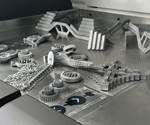One-Piece Robot Gripper Actuated by Shop Air
The pneumatic gripper 3D-printed as a complete working unit has demonstrated its effectiveness for continuous operation over time. It is one illustration of the role additive is liable to play in making robotic automation easier.
Additive manufacturing (AM) is an enabler to robotic automation, and the chief link between this automation and additive is the point at which the robot connects with its payload. 3D printing enables greater design freedom, lower cost and shorter lead time in producing custom grippers and end effectors for robotic applications.
IAM 3D Hub in Barcelona, Spain, recently developed a robot gripper that illustrates not only this link between robots and additive, but at least two other important points about AM as well—namely, the promise of part consolidation and the potential AM offers to realize transformative product functionality. That functionality is found in its actuation; the pneumatically-driven gripper is moved entirely by shop air, requiring no electrical connection. The actuator mechanism essentially expands like a balloon, closing the gripper’s fingers when air pressure is applied.
The gripper was printed in one piece on an HP Multi Jet Fusion 3D printer. The part consolidation here thus achieves not just an assembly unified into one piece, but more: a working mechanism made in one piece through a single additive build. Further, the fully dense polymer of the build, HP’s 3D High Reusability PA 12, delivers the airtightness that allows for pneumatic operation.
That polymer also offers the resiliency allowing the gripper’s spirals to function as springs. The material has proven durable, too. IAM 3D Hub reports it has been used successfully in a pick-and-place operation through one million cycles.
This video produced by HP shows the gripper in action:
Related Content
-
This 3D Printed Part Makes IndyCar Racing Safer: The Cool Parts Show #67
The top frame is a newer addition to Indycar vehicles, but one that has dramatically improved the safety of the sport. We look at the original component and its next generation in this episode of The Cool Parts Show.
-
3D Printed Lattices Replace Foam for Customized Helmet Padding: The Cool Parts Show #62
“Digital materials” resulting from engineered flexible polymer structures made through additive manufacturing are tunable to the application and can be tailored to the head of the wearer.
-
Implicit Modeling for Additive Manufacturing
Some software tools now use this modeling strategy as opposed to explicit methods of representing geometry. Here’s how it works, and why it matters for additive manufacturing.















